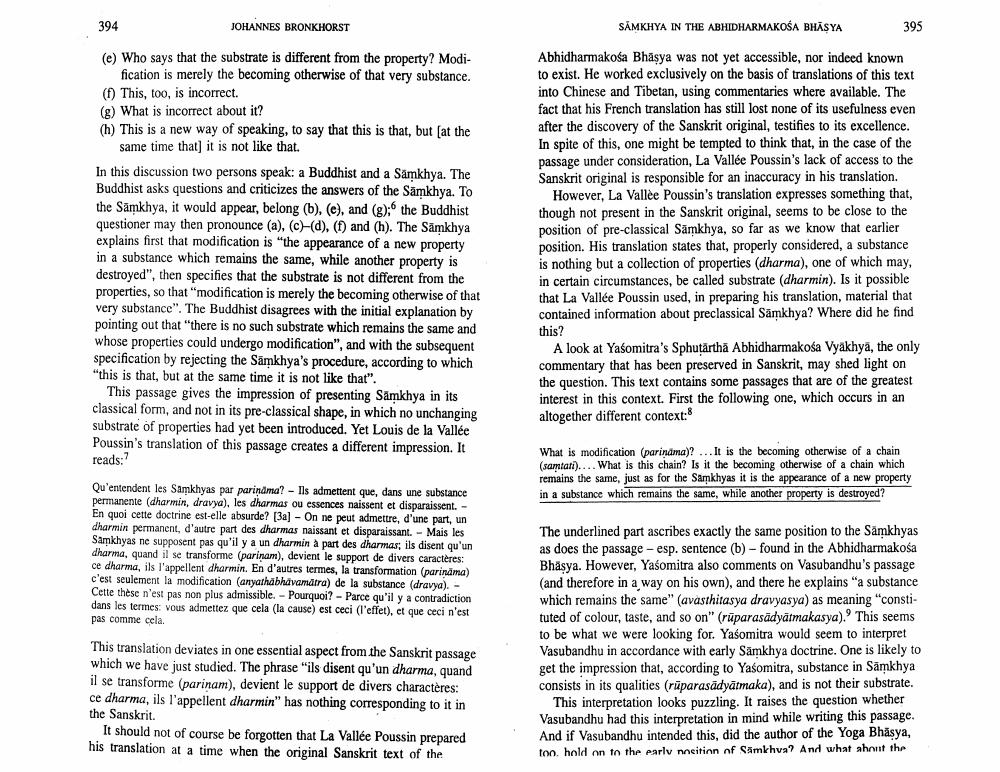Book Title: Samkhya In Abhidharmakosa Bhasya Author(s): Johannes Bronkhorst Publisher: Johannes Bronkhorst View full book textPage 2
________________ 394 JOHANNES BRONKHORST SAMKHYA IN THE ABHIDHARMAKOSA BHĀSYA 395 (e) Who says that the substrate is different from the property? Modi fication is merely the becoming otherwise of that very substance. (1) This, too, is incorrect. (g) What is incorrect about it? (h) This is a new way of speaking, to say that this is that, but [at the same time that it is not like that. In this discussion two persons speak: a Buddhist and a Samkhya. The Buddhist asks questions and criticizes the answers of the Samkhya. To the Samkhya, it would appear, belong (b), (c), and (8); the Buddhist questioner may then pronounce (a), (c)-(d), (f) and (h). The Samkhya explains first that modification is the appearance of a new property in a substance which remains the same, while another property is destroyed", then specifies that the substrate is not different from the properties, so that "modification is merely the becoming otherwise of that very substance". The Buddhist disagrees with the initial explanation by pointing out that there is no such substrate which remains the same and whose properties could undergo modification", and with the subsequent specification by rejecting the Samkhya's procedure, according to which "this is that, but at the same time it is not like that". This passage gives the impression of presenting Samkhya in its classical form, and not in its pre-classical shape, in which no unchanging substrate of properties had yet been introduced. Yet Louis de la Vallée Poussin's translation of this passage creates a different impression. It reads: Abhidharmakośa Bhasya was not yet accessible, nor indeed known to exist. He worked exclusively on the basis of translations of this text into Chinese and Tibetan, using commentaries where available. The fact that his French translation has still lost none of its usefulness even after the discovery of the Sanskrit original, testifies to its excellence. In spite of this, one might be tempted to think that, in the case of the passage under consideration, La Vallée Poussin's lack of access to the Sanskrit original is responsible for an inaccuracy in his translation. However, La Vallée Poussin's translation expresses something that, though not present in the Sanskrit original, seems to be close to the position of pre-classical Samkhya, so far as we know that earlier position. His translation states that, properly considered, a substance is nothing but a collection of properties (dharma), one of which may, in certain circumstances, be called substrate (dharmin). Is it possible that La Vallée Poussin used, in preparing his translation, material that contained information about preclassical Sāmkhya? Where did he find this? A look at Yašomitra's Sphuţartha Abhidharmakośa Vyakhya, the only commentary that has been preserved in Sanskrit, may shed light on the question. This text contains some passages that are of the greatest interest in this context. First the following one, which occurs in an altogether different context: What is modification (parindma)? ... It is the becoming otherwise of a chain (samiati).... What is this chain? Is it the becoming otherwise of a chain which remains the same, just as for the Samkhyas it is the appearance of a new property in a substance which remains the same, while another property is destroyed? Qu'entendent les Samkhyas par parindma? - Ils admettent que, dans une substance permanente (dharmin, dravya), les dharmas ou essences naissent et disparaissent. - En quoi cette doctrine est-elle absurde? (3a) - On ne peut admettre, d'une part, un dharmin permanent, d'autre part des dharmas naissant et disparaissant. - Mais les Samkhyas ne supposent pas qu'il y a un dharmin a part des dharmas, ils disent qu'un dharma, quand il se transforme (parinam), devient le support de divers caracteres ce dharma, ils l'appellent dharmin. En d'autres termes, la transformation (parināma) c'est seulement la modification (anyatha bhavamdra) de la substance (drava). - Cette thèse n'est pas non plus admissible. - Pourquoi? - Parce qu'il y a contradiction dans les termes: vous admettez que cela (la cause) est ceci (l'effet), et que ceci n'est pas comme cela. This translation deviates in one essential aspect from the Sanskrit passage which we have just studied. The phrase "ils disent qu'un dharma, quand il se transforme (parinam), devient le support de divers charactères: ce dharma, ils l'appellent dharmin" has nothing corresponding to it in the Sanskrit. It should not of course be forgotten that La Vallée Poussin prepared his translation at a time when the original Sanskrit text of the The underlined part ascribes exactly the same position to the Samkhyas as does the passage - esp. sentence (b) - found in the Abhidharmakosa Bhäsya. However, Yaśomitra also comments on Vasubandhu's passage (and therefore in a way on his own), and there he explains "a substance which remains the same" (avasthitasya dravyasya) as meaning "constituted of colour, taste, and so on" (rūparasādyatmakasya). This seems to be what we were looking for. Yaśomitra would seem to interpret Vasubandhu in accordance with early Samkhya doctrine. One is likely to get the impression that, according to Yasomitra, substance in Samkhya consists in its qualities (rüparasádyatmaka), and is not their substrate. This interpretation looks puzzling. It raises the question whether Vasubandhu had this interpretation in mind while writing this passage. And if Vasubandhu intended this, did the author of the Yoga Bhäsya, to hold on to the early nosition of Samkhva? And what about thePage Navigation
1 2 3 4 5
